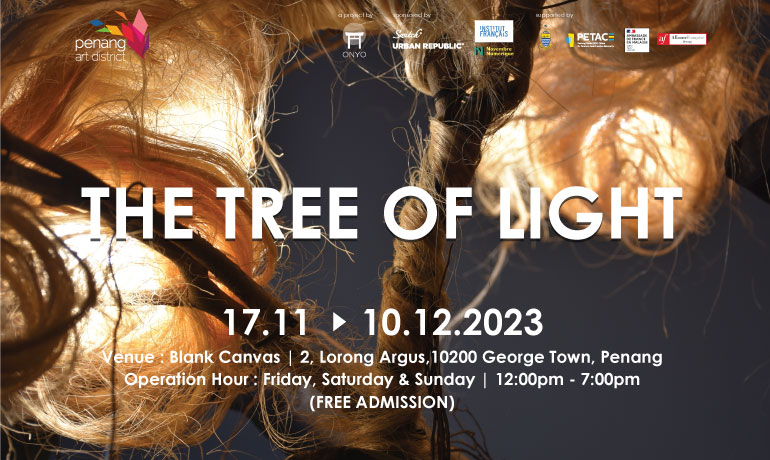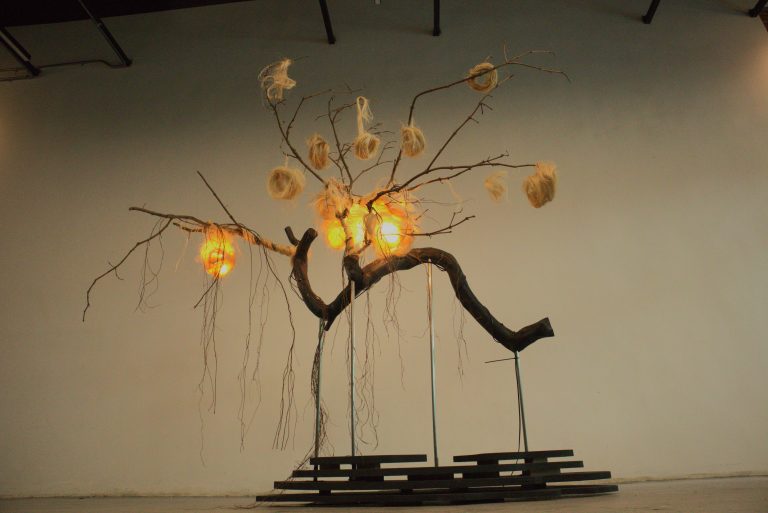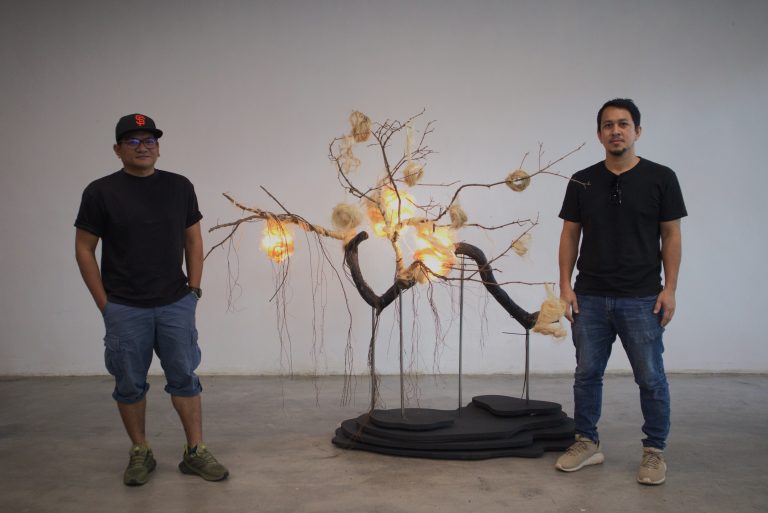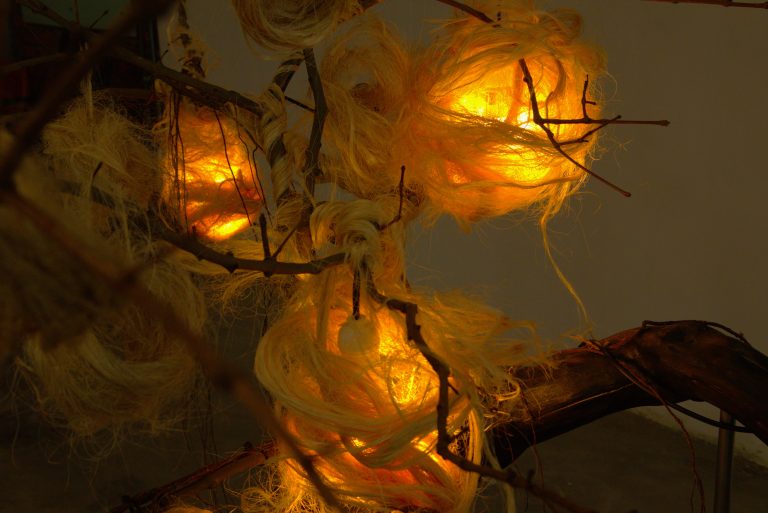An artistic alliance between French creatives at Onyo and USM Penang’s School of the Arts, The Tree of Light is slated to bring viewers into a multisensorial exhibition, exploring themes of regeneration, ritual, and healing.
By Liani MK
The Tree of Light looms over a dark, ashened island, its extended branches adorned with trailing orbs that glow softly.
Though modest in design, the tree sculpture emanates a mood that promises both comfort and refuge.
Described as a soundscape experience, the artwork is part of The Tree of Light, or L’arbre-Soleil, a multisensorial exhibition that opens at Blank Canvas from 17 November to 10 December. The exhibition is a result of an international collaboration between Paris-based company Onyo and Universiti Sains Malaysia (USM) School of the Arts that draws attention to the relationship between human beings and other living creatures.
Conceived by Charlotte-Amélie Veaux and Yann Garreau of the creative studio Onyo, the concept behind this exhibition is inspired by their personal encounters in nature, supplemented by an array of creative works that include video games, dance, mythological tales of Egypt and Japanese goddesses, as well as works of contemporary philosophers such as Baptiste Morizot.
“The experience invites you to regenerate a thousand-year-old tree. It’s an almost-sacred moment,” Garreau says, describing the exhibition. “It brings a mysticism conducive to intimate connections, both personal and collective, that give meaning to all participants.”
With passion and eloquence, Garreau expresses hope that the exhibition will remind visitors of the need for meaningful healing and environmental consciousness. “By regenerating this tree, we’ll realise that we’ve also regenerated ourselves. And to give all the power to this ritual, we decided to work with sound and lighting technologies to bring depth to the whole, and a unique magical dimension.”
To create this ritualistic experience, Garreau emphasises that sound is deliberately central to the exhibition. “We made this choice because we live in a society of images, and we need to learn to see with our other senses. And sound is the sense of imagination,” he says, adding that they worked with Radio France and sound designers to create this experience.
Encouraging active participation, the exhibition invites visitors to wear headphones and turn their attention towards the handmade tree sculpture. They are encouraged to interact with its elements, following guided instructions for actions like breathing exercises that are designed to “revive” the tree. The immersive element is not only symbolic; it aims to inspire a way of thinking about how we relate to living beings in the world.
“If you play along, then the magic of the experience is yours,” Garreau says. “The rhythm of this exercise is designed to do you good. It’s thanks in part to these interactions that you emerge completely soothed at the end of the experience.”
ROOTED IN LOCAL EXPRESSIONS
Departing from their customary practices, the exhibition reflects a cross-cultural collaboration that merges this French concept with distinctive elements of Malaysian culture.
“The city is very much a part of our thinking,” says Garreau. “In fact, Penang is very much in the Onyo spirit. There’s an abundance of biodiversity, myths, and an important cultural scene, which makes it easier to propose our work. For our part, we’re very curious to discover how the work will be perceived by the public.”
This is the first time the tree sculpture was not made in France by Onyo’s usual craftsman, Charles Macaire. Instead, it emerged from the skilled hands of USM lecturers and students with a localised context which, Garreau believes, would help visitors resonate with the exhibition better.
According to Mohd Alif Ikrami bin Mutti, who led the team behind the tree sculpture, it was an opportunity to showcase Malaysian sensibilities. “We really wanted to let people into this world of what we imagine to be a form of healing, but in a local context.”
Local elements are therefore prominent with the use of sustainable, biodegradable materials such as banana fibre for the leaves. Ikrami shares that they selected banana fibre as it was lighter in colour, which would glow better when light passes through it.
“We use this fibre as the leaves trailing from our tree sculpture, because it’s more sustainable, long lasting, and it will look different,” says Ikrami, who is a lecturer and has a background in product design at USM School of the Arts.
Other considerations in the exhibition include the use of mengkuang mats, made from local screwpine leaves. This, he says, will be laid out for visitors to sit on, instead of chairs.
“Almost 85% of the materials are sourced from nature,” adds Mhd Sany bin Mhd Hanif, a PhD candidate in product design at the USM School of the Arts, who helped build this sculpture. “We made it from scratch: none of these are synthetic.”
The interdisciplinary nature of the sculpture is also evident as Ikrami and his team incorporates their background in product design: Ikrami made sure that the tree sculpture could be easily dismantled and reassembled to ease transportation, demonstrating a commitment to both sustainability and functionality.
“It’s an artwork that uses the design process. Meaning, it is both artistic and functional,” Ikrami says, adding that the process has been refreshing for him. “This is an interdisciplinary artwork that is very interesting and new to me. I’d like to see how it comes together with the sound and the entire exhibition.”
Inspired by these insights, Ikrami expresses his appreciation for platforms like Penang Art District and the state government for enabling these collaborations to take place. Collaborations like this, he says, stimulates the local arts scene and helps local creatives collaborate with artists across the world. “I really like this type of work and can’t wait to do more projects like this,” he says.
STIRRING CHANGE
The Tree of Light moves beyond a mere art installation: it carries a deeper significance in today’s context amid increasing climate change anxieties.
“[Climate change] is provoking a great deal of fear and uncertainty about our future,” says Garreau. “We need other narratives, other stories to imagine other possible worlds. Stories that are more beautiful, more positive, that make us want to act. The Tree of Light is a very simple story, but it’s part of this movement, and should restore hope and wonder, and help us regenerate as a society.”
The culmination of this exhibition does not stop at external pursuits. It is also healing for the artists themselves. “Besides,” says Ikrami thoughtfully, “we are originally from nature.”
“Nowadays, there’s a lot of technology involved in people’s lives,” adds Sany. “By looking at our work of art and experiencing the ambience, hopefully people get closer to nature. I think this is the main idea that we want the audience to have and feel.”
Garreau’s hope is that visitors will carry the experience with them and be moved with a sense of awe and wonder.
“I hope they will remember it as a powerful moment of connection with the living world,” he says.
This innovative exchange program is made possible by Penang Art District and sponsor from Institut Français as part of the global Novembre Numérique initiative and Switch/Urban Republic. With the endorsements from PETACE, the Embassy of France in Malaysia and Alliance Française de Penang, aims to cultivate cultural and creative connections between Penang and France.
Liani MK is an independent journalist, writer and artist who focuses on migration, indigenous rights, film, and culture.
All photos by Arieff Zafir.




